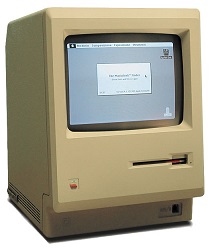 On January 24, 2014 the Apple Macintosh computer celebrated its 30th anniversary. Welcome to the club! Much has changed in the personal computer market since then and the advances in technology have been breathtaking. While not every desk has a Mac on it, the influences of the Mac have changed personal and business computing for everyone and emulating some of Apple’s growth strategies may have a similar positive effect on your businesses’ bottom line.
On January 24, 2014 the Apple Macintosh computer celebrated its 30th anniversary. Welcome to the club! Much has changed in the personal computer market since then and the advances in technology have been breathtaking. While not every desk has a Mac on it, the influences of the Mac have changed personal and business computing for everyone and emulating some of Apple’s growth strategies may have a similar positive effect on your businesses’ bottom line.
1. Make a Splash, a BIG Splash
The introduction of the Macintosh was a huge media event. This is a crude video of a young Steve Jobs introducing Macintosh in 1984 at the Flint Center in Cupertino, California. The famous 1984 ad that introduced Macintosh to the public ran during the 1984 Super Bowl was directed by Ridley Scott, who directed Alien, Blade Runner and Gladiator among other major films. The tag line at the end of the commercial was short and to the point: "On January 24th, Apple Computer will introduce Macintosh. And you'll see why 1984 won't be like '1984.'" With a video directed by Ridley Scott aired during the Super Bowl Jobs guaranteed the biggest of splashes.
2. Innovation or Bust
 The Macintosh was different in many ways. Users could use a mouse to pull down menu items on the screen, fonts could be changed from the standard Times and Helvetica, files could be dragged into folders using the mouse, type could be copied and pasted, and the user interface was WYSIWYG (what you see is what you get) as opposed to using MS DOS commands to edit your computer files. Much of the credit for this interface goes to PARC, or the Palo Alto Research Center, being run by Xerox who developed this new computer technology but had no plans of actually introducing it to the market. Steve Jobs visited PARC with Apple engineers and asked to use this new technology, and they let him. These innovations and many more have guaranteed Apple, Mac and Jobs' place in history.
The Macintosh was different in many ways. Users could use a mouse to pull down menu items on the screen, fonts could be changed from the standard Times and Helvetica, files could be dragged into folders using the mouse, type could be copied and pasted, and the user interface was WYSIWYG (what you see is what you get) as opposed to using MS DOS commands to edit your computer files. Much of the credit for this interface goes to PARC, or the Palo Alto Research Center, being run by Xerox who developed this new computer technology but had no plans of actually introducing it to the market. Steve Jobs visited PARC with Apple engineers and asked to use this new technology, and they let him. These innovations and many more have guaranteed Apple, Mac and Jobs' place in history.
3. Pay the Cost to be Your Own Boss
In the 1980s and much of the 1990s the computer was a very expensive purchase. Most small businesses could not afford to provide computers to all employees and having a home computer was known to only a few consumers. The Mac helped bring about the proliferation of  the personal computer by offering low cost Macs to the market. The Mac Classic (pictured) was introduced in 1993 and cost less than $1,000. With this low cost and powerful computer, the home market expanded and many people could do their own "desktop publishing" by designing and printing your own newsletters, envelopes, letterhead, and other graphic related work that you previously had to send out to print shops or graphic designers.
the personal computer by offering low cost Macs to the market. The Mac Classic (pictured) was introduced in 1993 and cost less than $1,000. With this low cost and powerful computer, the home market expanded and many people could do their own "desktop publishing" by designing and printing your own newsletters, envelopes, letterhead, and other graphic related work that you previously had to send out to print shops or graphic designers.
In 1989, Apple made an innovative computer designed to be the first Macintosh "portable" computer. This turned out to be the forefather of the laptop computer that is so prevalent today. The portable computer was large and weighed only 15.8 pounds. The portable Mac's cost of $6,500 was the epitome of sticker shock, so it did not set the world on fire at the time, but the idea had legs and the early PowerBooks and iBooks that followed quickly morphed into smaller, cheaper, and lighter models that gained market share.
4. Image is Everything
In 1998, Apple changed the look of computers by introducing the first iMac. These iMacs were a single unit with curved translucent color shells in blue, red, orange, or green. The groundbreaking feature of the iMac besides its colorful outer appearance and the combination of the CPU and monitor was the lack of a floppy disk drive. Apple decided that computing was moving to a more internet-based exchange of files. The iMacs had a CD drive in the front of the machine and two USB ports on the side. This was a revolutionary change from the beige boxes that had come to define computers at the time.


